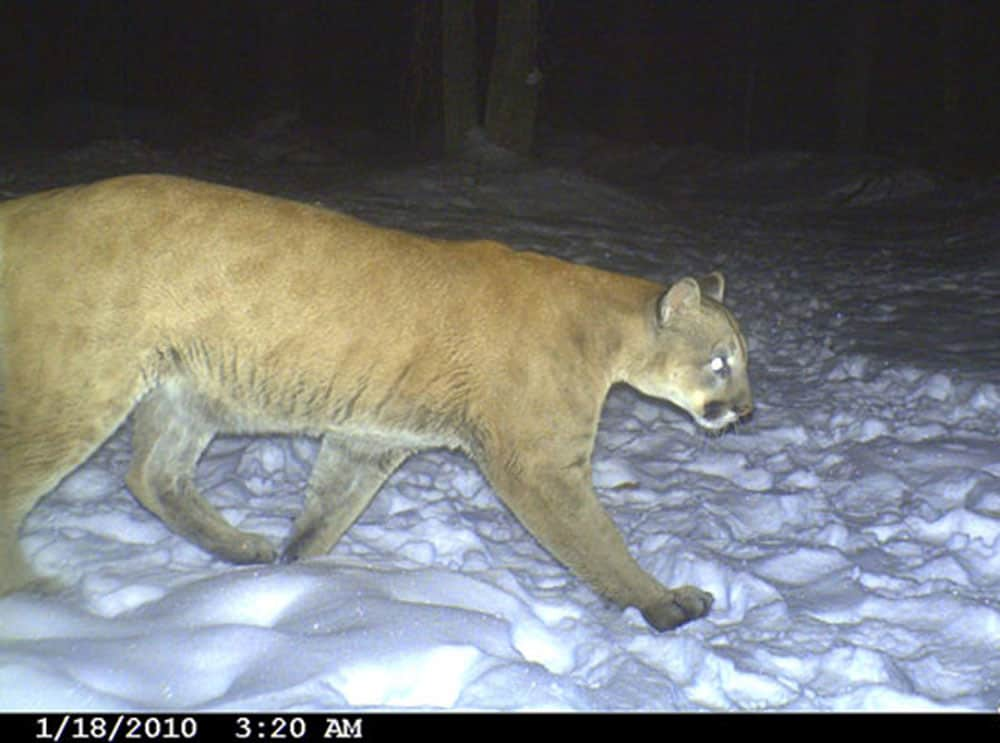WI Cougar Sightings Continue, No Evidence They’re Settling Down
Patrick Durkin 09.09.15

Seven years after the Wisconsin Department of Natural Resources (DNR) confirmed that a cougar was roaming the state for the first time in a century, it remains unlikely that North America’s largest wildcat has reestablished a breeding population in the Badger State.
All six cougars the DNR has since identified through DNA samples from hair, blood, urine, or feces samples were males from South Dakota’s Black Hills. These toms were most likely juveniles passing through on futile searches to establish breeding territories.
By definition, breeding territories include at least one female cougar. Without a female’s presence and cooperation, no male cougar will beget a breeding population.
Granted, a female cougar could live in Wisconsin without the DNR’s knowledge, but it’s far more likely none has made it that far. After all, Iowa and Minnesota have yet to verify a breeding cougar population, either. Given that cougars born in South Dakota must pass through Iowa or Minnesota to reach Wisconsin, it seems logical the Hawkeye or Gopher state would find breeding cougars before Wisconsin would.
In addition, female cougars rarely roam like males. Jane Wiedenhoeft, a DNR biologist in Park Falls, Wisconsin, who often investigates cougar reports, said mature males drive juvenile males from their territories. In contrast, cougars don’t persecute juvenile females, so they seldom move far from their home turf before becoming breeders.
Therefore, cougars expand their range slowly, no matter how relentlessly juvenile males search for mates and their own breeding territory. And if they make it 500-plus miles to Wisconsin, they’re likely so frustrated by the females’ absence that they seldom stop moving.
For instance, the first male cougar documented in modern-day Wisconsin was a juvenile from South Dakota that fled a Milton farmer’s hayloft in January 2008 in southeastern Wisconsin. After disappearing from Rock County, the young cat was shot and killed three months later by Chicago police.

In 2011, a male cougar from South Dakota was struck and killed on a Connecticut highway. DNA evidence confirmed it was the same tom seen several times between December 2009 and May 2010 in northern Wisconsin and Michigan’s Upper Peninsula. Its 1,500-mile journey lasted about three years.
Wiedenhoeft said the Wisconsin DNR has confirmed at least one cougar sighting every year since 2008, including three this year, all in July, all possibly the same cat. Two trail-camera photos taken July 9 six miles and 20 hours apart showed a cougar in Langlade County. Then on July 19, a trail camera 60 miles away in Marinette County documented the third sighting.
During the past seven-plus years, the Wisconsin DNR has also verified cougar sightings in Ashland, Bayfield, Buffalo, Forest, Florence, Iowa, Jackson, Juneau, Lincoln, Marathon, Monroe, Oconto, Price, Rusk, Sawyer, Trempealeau, and Waushara counties. In several cases, DNR biologists think the same cougar accounted for multiple sightings.

Perhaps not coincidentally, the number of possible cougar sightings reported to the Wisconsin DNR has jumped since that first confirmation in January 2008. From 2000 to 2005, the agency received 336 such reports, an annual average of 56. The sightings then rose to 102 in 2006 and 113 in 2007, before jumping 57 percent to 177 in 2008.
But that was just the warm-up act. Possible cougar sightings in Wisconsin jumped 38 percent to 244 in 2009 and haven’t been below 240 since. The record years for cougar sightings were 385 in 2010 and 390 in 2012. A year-by-year breakdown of cougar sightings reported in Wisconsin from 2000 through 2014 can be seen below:
| Year | Reported cougar sightings |
| 2014 | 285 |
| 2013 | 240 |
| 2012 | 390 |
| 2011 | 281 |
| 2010 | 385 |
| 2009 | 244 |
| 2008 | 177 |
| 2007 | 113 |
| 2006 | 102 |
| 2005 | 76 |
| 2004 | 71 |
| 2003 | 55 |
| 2002 | 49 |
| 2001 | 42 |
| 2000 | 43 |
In fact, from 2008 through 2014 the Wisconsin DNR recorded 2,002 reports of possible cougar sightings (286 annual average), of which 376 (19 percent) included enough evidence—such as tracks, feces, hair, and/or trail-cam photos—to justify trying to identify the species. Of those 376 cases with physical evidence, 70 percent were verified as something besides a cougar. Attempts to verify the other 30 percent usually proved inconclusive.
“Most people who report a cougar sighting are convinced they know what they’re looking at, but our data collection indicates they don’t always know,” Wiedenhoeft said. “Depending on the light, the setting, the distance and viewing angle, many things can look like a cougar.”

Wiedenhoeft said most verifications in recent years have come from trail cameras, motion-activated devices used by hunters and landowners to see what’s roaming the land. In all such cases, DNR personnel visit the site to search for and inspect physical evidence, and measure items seen in trail-cam photos to help estimate the animal’s size.
An adult male cougar weighs 116 to 160 pounds and measures 80 to 95 inches. An adult female weighs 75 to 110 pounds and measures 72 to 80 inches. Cougars stand 27 to 31 inches at the shoulder, and their tails have a black tip and measure 28 to 38 inches.
Even with photos, however, it’s often hard to verify a cougar, or identify it as something else. Most cat-like photos turn out to be bobcats. If a bobcat’s rear and stubby tail are obscured by brush or orientation to the camera, bright white patches on their ears’ backsides provide positive ID.
Even though most cougar sightings prove erroneous, the Wisconsin DNR encourages people to report possible sightings as soon as possible. The same goes if you think you spotted a moose, lynx, wolf, wolverine, or other unusual mammal. The reports can be filed online here.

